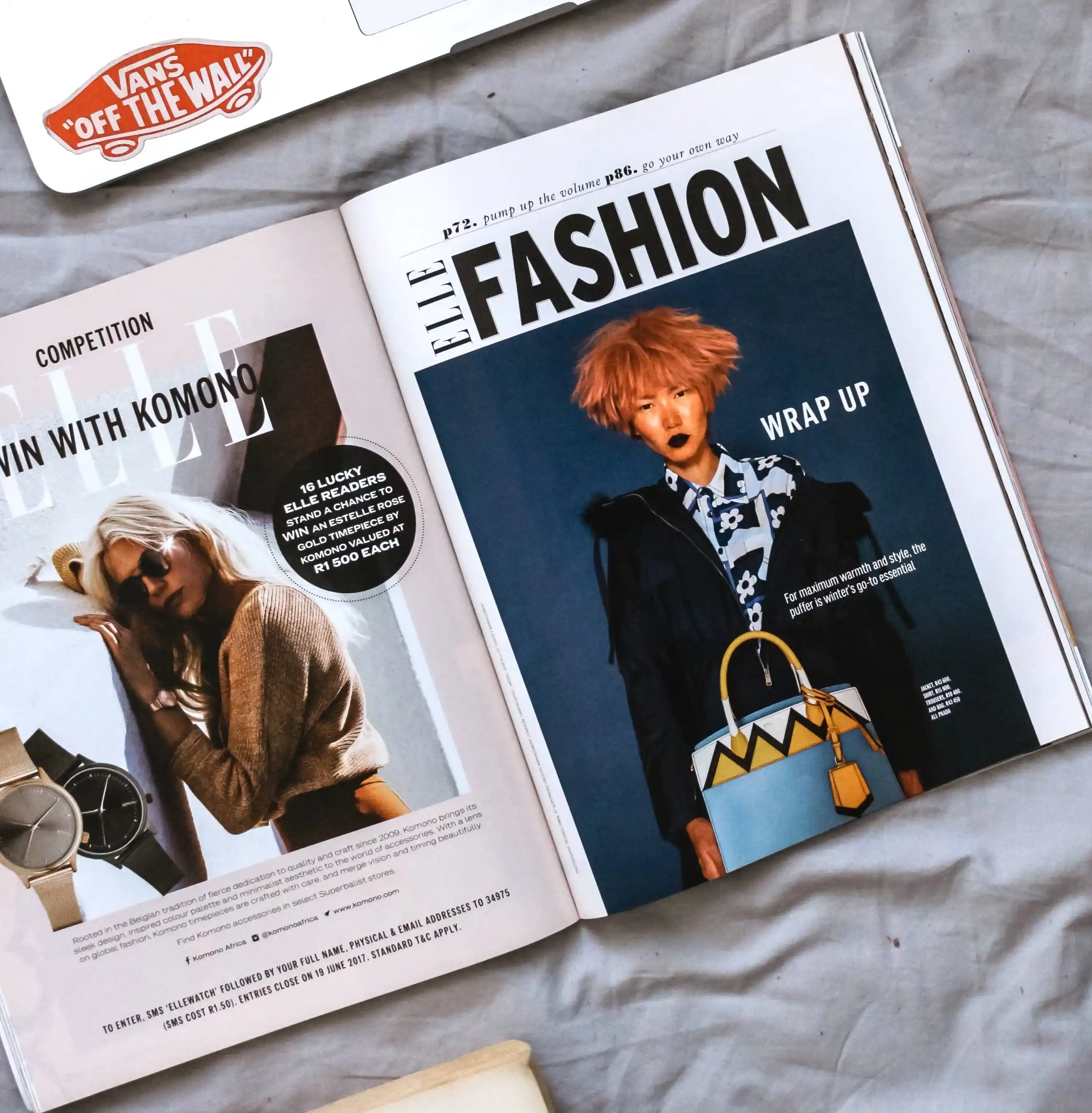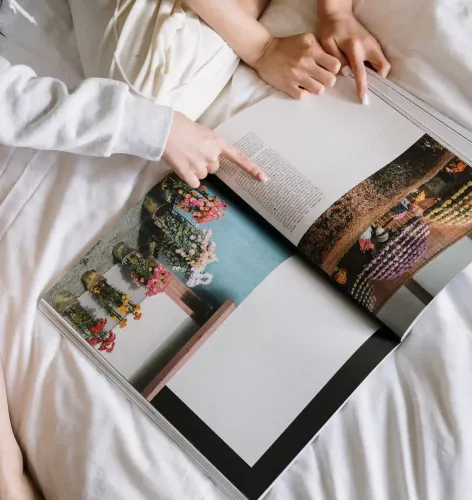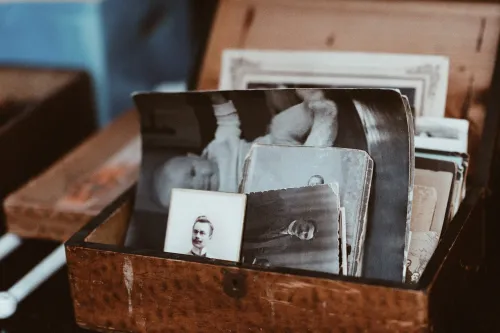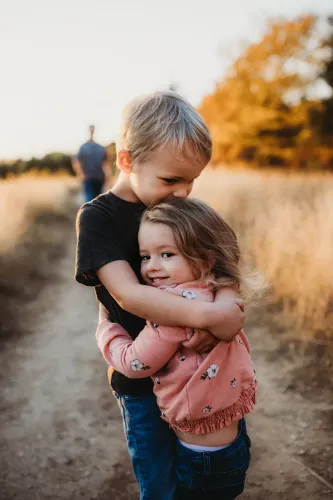Every magazine has a few fixed sections: 'Read, look and listen' and 'Conversation of the day' in Margriet, the fashion report in ELLE, or the shopping pages in Libelle. If you make your own magazine, you can also use different sections. This will give your magazine a creative twist and a professional look.
All the sample pages shown in this article can be found as templates in the makerspace. Place the desired template on your page and customise it with your own texts and/or photos.
Here you will find 44 different magazine sections. So you can be creative! Which categories will you choose for your own magazine?
Section 1. Cover
Is the cover a heading? Maybe not strictly speaking, but it is a fixed part of your magazine. It is also a very important page: your readers will see the front page first.
Read 5 tips for an even more beautiful cover here.
Section 2. Table of contents
The table of contents makes it clear at a glance what is in your magazine. Indicate which article you can find where. Highlight a few articles by repeating the photo of that page in the Table of Contents, and by including the title and page number. And don't forget: a table of contents can easily be two or three pages long, especially if you're making a big magazine.
Section 3. Editorial
On one of the first pages of the magazine, you can place an editorial. This is a short preface by the chiefmaker. In it, you can explain why you have made this magazine, and with whom. You can also briefly mention what you can read in the magazine. Add a nice portrait photo to the editorial and sign your own name.
Section 4. Colophon
The colophon is an indispensable part of a self-made magazine. List all the names of the people who have contributed to the magazine.
Example of a colophon page - table of contents.jpg
Section 5. News item
A news report is structured in such a way that you start at the top with the most important thing. A news report is factual. You can put several short news items on a page or one long news item. For a gift magazine, it can be fun to 'invent' news items. This gives the content of your magazine something playful and cheerful. But you can also present past experiences as 'news' in the magazine.
Section 6. Photo Report
The word says it all: in a photo reportage, you use a lot of photo material. It is a good idea to print the photos in the report as full pages. A photo reportage usually deals with a single subject. All the photos are about that subject. In a photo reportage, use short texts that add something to the photo. Use good quality photos for your reportage.
Looking for tips on choosing the right images? We'll be happy to give you advice.
Section 7. Fashion Report
Also in a fashion shoot it is nice to use a lot of large images. As with the general photo report, put short texts next to the photos.
Section 8. Travel report
The travel reportage lends itself well to a nice mix of text and photography. You can write a longer text about a particular country, region or city. Place several photos in your report and alternate between detailed shots and overview photos. The travel report is often informative.
Section 9. Hiking Trip
The walking route is an extension of the travel report. If you are making a magazine for someone who likes to walk, you can include a route in the magazine. This contains a description of the route and some photos of what you might encounter along the way.
Section 10. Cycle route
For the bicycle lover, you can include a bicycle route in your magazine. Write out the route and place it in the magazine. You can design the page with photos of the surroundings of the route, for example.
On the internet, you can find and plan cycling and walking routes on various websites. In the example below you can use Route.nl
Section 11. Interior Design
Does the person you are making a magazine for like interior design and home decorating magazines a lot? Then make a photo reportage about living. Use multiple photos, place some images full page, and add a short description to the images. (Of course, you can also secretly photograph the interior of the person for whom you are making a magazine).
Section 12. Backstory
A background story consists for a large part of text in which you tell about the person in question. Tell something about this person, his/her past or choose a subject that you will cover in detail. You can 'cut' the long text into short pieces by using blank lines and subheadings. Is your background story several pages long? Use small boxes to lighten the layout of the page.
Section 13. Informative article
In an informative article you explain how something works. You can either wrap this up in short pieces of text and add a photo to each one, or make it one long continuous text. Inform and remain factual.
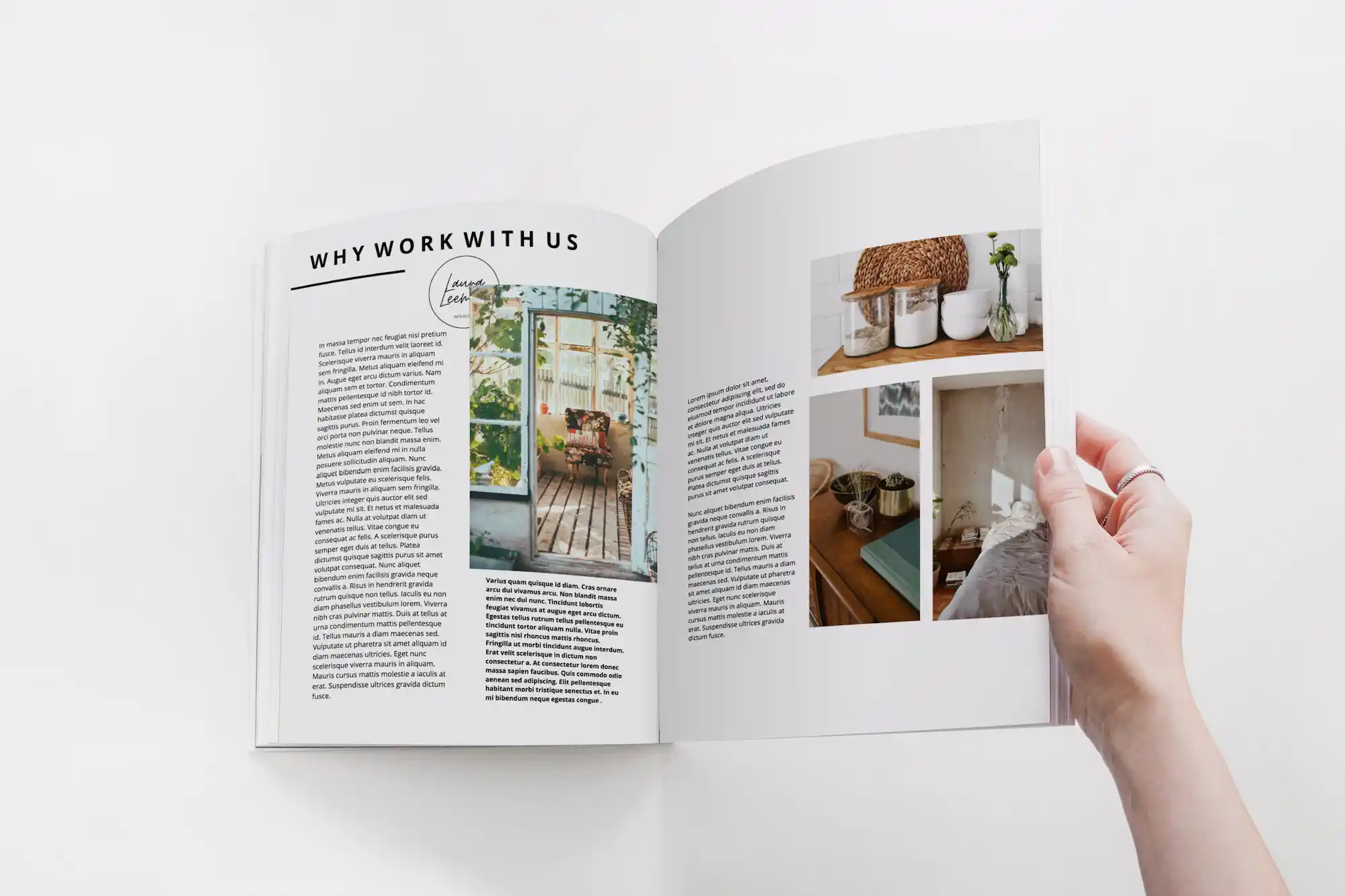
Section 14. Book Review
In the book review, you describe one or more books and give it a value: do you like the book or not and why, what is the story, in what genre is it written and what can you, as a reader, expect from this book? Add a picture of the cover and/or the author. With stars (0 to 5 stars for example), you indicate how interesting you find the book.
Section 15. Movie Review
Does the person you're making the magazine for like to watch films? Great! Then include a few film reviews in your magazine. You can fill a page with very short reviews - with or without stars indicating the quality of the film - or write longer reviews and fill several pages with your film reviews. Include a picture of the film in your review, mention the year it was released, who the director is, what actors are in it and what the story is about.
Section 16. Game Review
If you are making a magazine for someone who likes to play games, then a page with reviews of the best games should be included. In a game review, state what you can do with the game, how you can play it, what's good about it and what the purpose of the game is.
With stars (from 0 to 4) you indicate what you think of the game. Adding a photo is nice. Please note that pictures from the Internet have a low resolution and are not of sufficient quality for printing.
Section 17. Theatre review
It is fun for theatre lovers to read reviews in their own magazine of great performances they have been to, would like to go to, would absolutely never want to go to, and maybe even played in.
Add pictures and give each performance a ranking. In your review, tell about the scenery, the actors, the play, the direction, the story and how the play is presented.
samplepages-book-movie-reviews.jpg
Section 18. Cooking section (things to cook with)
With a cooking section, you can go in different directions. Next to the recipes, you can discuss fun gadgets for the kitchen. This is especially fun if the person you are making the magazine for is really into cooking and gadgets. Take beautiful photos of the items you put in the magazine, write a short description with them and put several items on one page.
Section 19. Cooking section (recipes page)
A recipe in the magazine is always nice. Choose a favourite recipe of the person for whom you are making the magazine, or ask all the editors who are collaborating on the magazine to place their own favourite recipe in it. Of course, there is a title above the recipe, a list of ingredients and a preparation method. A photo of the prepared recipe completes your page.
You can also search for recipes that match a certain theme. For example, for a [wedding] magazine (https://jilster.app/item/wedding-gift/) you might look for romantic recipes for 2 people, while for your grandmother's [birthday] (https://jilster.app/item/birthday-magazine/) you might opt for traditional family recipes. This way, your recipe page will be even better aligned with the content of your magazine.
samplepages-receptions.jpg
Section 20. Interview short
An interview makes your magazine come alive. A short interview gives a completely different picture and atmosphere than a long interview. You can use a short interview in combination with a full-page portrait photo, for example. A short interview consists of three to five questions.
You can choose to have all editors who collaborate on the magazine answer the same questions. This will give structure to your magazine. Then, choose questions that really fit the person for whom you are making the magazine. A short interview can be written in the question-answer format.
Section 21. Long interview
A long interview can be represented in your magazine in various ways. You can make it a question-answer interview, a text consisting entirely of quotations (the interviewee speaks from beginning to end), or a mixture of quotations and descriptions. If you place a long interview in your magazine, make sure that you insert a blank line on the page every now and then. Headings will also lighten your page layout.
Section 22. Column
A column is a short text of one column width. It is often an amusing anecdote or a vicious piece about something or someone. Tip: keep your column positive! After all, you are creating a personal gift for someone. It is nice to add a small portrait and the author's name to your column.
samplepages-column-interview.jpg
Section 23. Advertisement or Advertorial
In your own magazine, you can use a lot of creativity in creating (fake) advertisements or advertorials. Choose products that the person you are making the magazine for likes. Come up with an ad text that fits that person or look at the original ad pages of the product and recreate them with a wink.
Section 24. Adverts
You can fill a page with small ads or calls for tenders. You can think of personals, courses, houses for sale, holiday destinations, cars for sale and you name it.
Section 25. Letter section
Ah, the old familiar letters section. In big magazines like Margriet or Libelle, you'll find a few pages with letters sent in by readers. You can ask the editors who collaborate on the magazine to write a letter. But you can also make up funny and touching letters that relate to the life of the person for whom you are making a magazine. Add a title to each letter and end with a real or imagined name and place.
samplepages-column-calls-letters-heading.jpg
Rubicle 26. Do-it-yourself page
Are you making a magazine for a handyman or a real creative person? Then create a page in which you explain and show how to make something in a number of steps. This could be a cabinet for the real DIYer, but also knitting a baby's hat or papering a wall.
Section 27. Sequel
Are you making more than one magazine of your own? Then cut a story in several pieces and place a part of the story in each issue.
Section 28. Comic
You can easily draw a comic strip by hand and on paper, then scan it and upload it into your own magazine.
samplepages-column-calls-letters.jpg
Section 29. Great (web) addresses (shopping)
Collect favourite shopping addresses of the person for whom you are making a magazine. These can be real shops or web shops. Make a short description of the shop and put several shopping addresses on one page. Add a small photo to each address and your shopping page is complete!
Original idea: by placing QR codes in the magazine, you can refer to links on the Internet or to films on YouTube. Would you like to know more about placing QR codes in your magazine? Click here
Section 30. Advice from experts (Dear Mona)
By asking an expert a question you can give an informative article a fun twist. It's also a great way to bring up a precarious topic.
Section 31. Portrait(s)
You can place a portrait in the form of a photo. It can be a full-page spread or a series of smaller portraits. But you can also portray someone in keywords or in sentences. Collect typical words and sayings of the person for whom you are creating a journal. Place these individual words and phrases in a large font on the page. You can add dates such as date of birth, place of birth, place of residence, marital status, etc. It is also fun to ask each editor to make a portrait page of themselves. That way, everyone is in it with their own photo.
Looking for tips on choosing the right images? We are happy to give you advice!
Section 32. Diary
A diary, isn't that far too personal for a magazine section? Well, it doesn't have to be. It's nice to choose the form of a diary for a change. For example, you can use it to describe a day in the life of someone. This can be your own life, but also the life of the person for whom you are making a journal.
Of course, you start the page with 'Dear Diary'. For a better diary effect, you can choose a template that looks like a page from a notebook. Or scan a handwritten sheet of paper and upload it into Jilster.
Write in the 'I' form, put a date on your page and tell what happened that day. Finish with your name.
sample-pages-advice-by-experts-portrait.jpg
Section 33. Survey
You have probably been asked to take part in a survey. This can be about anything: from the best fries in your neighbourhood to the nicest place to live in the Netherlands. You can also make a survey for your own magazine.
Section 34. Quiz
Make a quiz and test the knowledge of the person for whom you are making a magazine. What does he remember about events in his own life? And how about his knowledge of cars, football or the history of his hometown? Or, as in the example opposite: what does he know about her and she about him?
A quiz is made by first choosing a subject. Take a hobby of the person you are making a magazine for or collect a few facts from their life. Draw up questions and give three or four possible answers per question. Of course, one of the answers is the only correct one. And, of course, there is one answer that makes you laugh.
Are you going to make a marriage magazine? We'd love to give you tips on how to create marriage games and relationship horoscopes!
Section 35. Story (fiction)
Are you a good writer? Or is one of the editors good at writing stories? If so, place a story of your own in the magazine. It is extra nice if the story applies to the person who receives the magazine. It also looks good with a nice illustration or photo. Don't forget to mention the author's name.
Section 36. Beauty section
Devote a page (or two) to beauty tips. Which make-up suits the person you are making the magazine for? What new hairstyle do you recommend? How would he look with or without a moustache? How would a different hair colour affect his appearance?
Place a photo of the person you are making a magazine for and tell what you like about him or her. This way you make it a positive article. In addition, give some suggestions for an even more beautiful appearance. Although, is that even possible? After all, you love him or her just the way he or she is. 🙂
example-pages-quiz-story.jpg
Section 37. Before & after (make-over)
This is a great section for your own magazine. You can use it in many different ways. For example, you can show a make-over of a person: how someone normally looks and how they look with a new hairstyle, (new) make-up and in a different style of clothing.
Or make a make-over of someone's house; what did the house look like when they bought it and what does it look like after the renovation? Read the nice story of Esther: she made a whole magazine about her house and interior!
Section 38. Gadgets or favourites page
What are the favourite items and brands of the person you are making a magazine for? Photograph them and place them full-page in the magazine. With a short explanation you have a beautiful gadget or favourites page!
Section 39. Lists: The 8 best tips
Lists are always good. For example, make a page with the 9 best hard rock bands in the Netherlands (for the real hard rock fan); with the 13 best novels of all time (for the reading fan); the 5 best amusement parks (so that grandma can take her grandchildren there) or the 77 best cake recipes (uhm yes, that's already a whole magazine full!).
example-pages-favourites-top-list.jpg
Section 40. The making of
If you enjoy working on your magazine together, take a photo during the process. Maybe you get together as family members or friends to brainstorm or have a photo session for the magazine. Capture the joy of making a magazine together and make it a separate page or spread.
Section 41. Gossip column
Magazines such as Story or Privé are masters at it: gossip stories! The trick is to write the articles in such a way that it may or may not be true. Often the title consists of a question - which, by the way, is not answered! You can do that too, at least to some extent. But keep it positive. Think of a title like "Are Jack and Paulien still happy?", "Does Jenny love her canary enough?" or "Is Harry so slim because of his work?".
Section 42. Horoscope
Which sign is the person you are making a magazine for? Aries, Cancer, Sagittarius? Write a custom horoscope for him!
Section 43. Puzzle page
It's also fun to add a puzzle page to your magazine. Of course, you can copy a ready-made puzzle from the Internet and paste it into your magazine, but it's much more original to create a personal puzzle! Think, for example, of a word search or a crossword puzzle about the birthday boy or girl, your colleague who is saying goodbye, or the wedding couple. Think up fun, interesting and amusing questions and incorporate the answers into the puzzle.
Are you going to make a wedding magazine? We are happy to give you tips on how to create [wedding games and relationship horoscopes]!(https://www.jilster.nl/themas/huwelijkscadeau/)
example-pages-puzzle-horoscope.jpg
Section 44. Back page
It may sound a bit silly to name the back page as its own section. But because of its place in the magazine, it deserves some extra attention.
You can see the back page in connection with the cover. If you want to, you can use the same atmosphere, colours and font as on the front of the magazine. That way you get a beautiful cover.
Another option is to use the back page as advertising space. Think of an appropriate product for the recipient of the magazine. Or recreate an existing advert for his favourite product.
